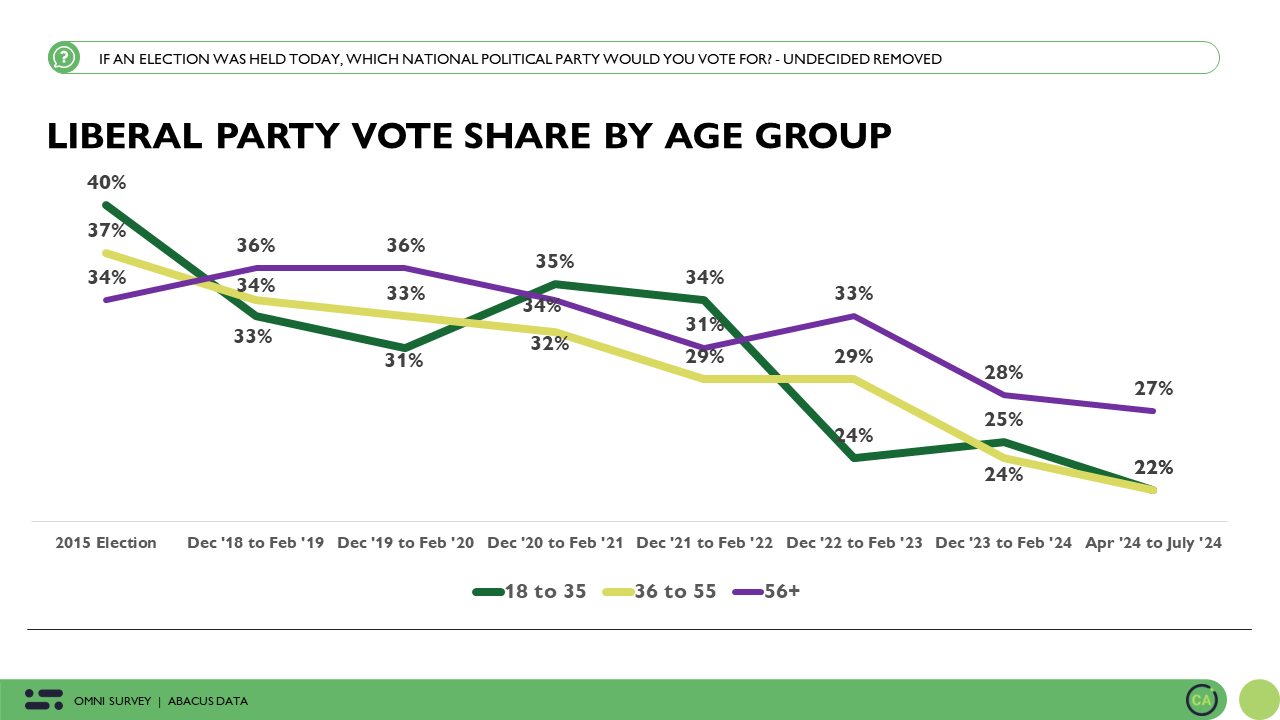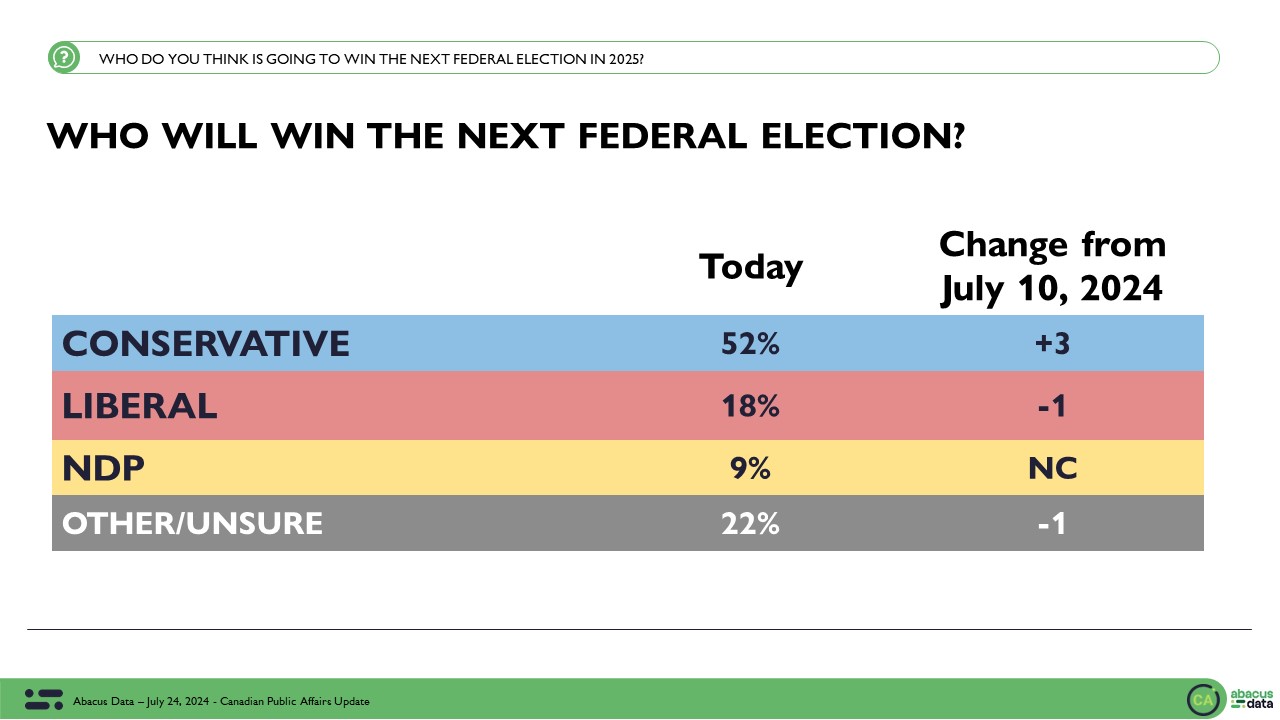What’s fueling Canada’s Green Party?
June 3, 2019
DIGGING INTO THE GREEN STORY
Last week, we reported that 12% of those who had a committed choice today said they would vote Green, which represents 9% of the adult voting age population. Another 35% say they would consider voting Green, totaling 44%. This is more than enough to win an election, but the chances of converting all accessible voters are fairly slim, based on the past experience not only of the Greens but of other parties.

The potential Green voter pool is 35% among those 60 or older, and a whopping 58% among those under 30. The accessible Green pool is large enough to have a major impact on every part of the country.
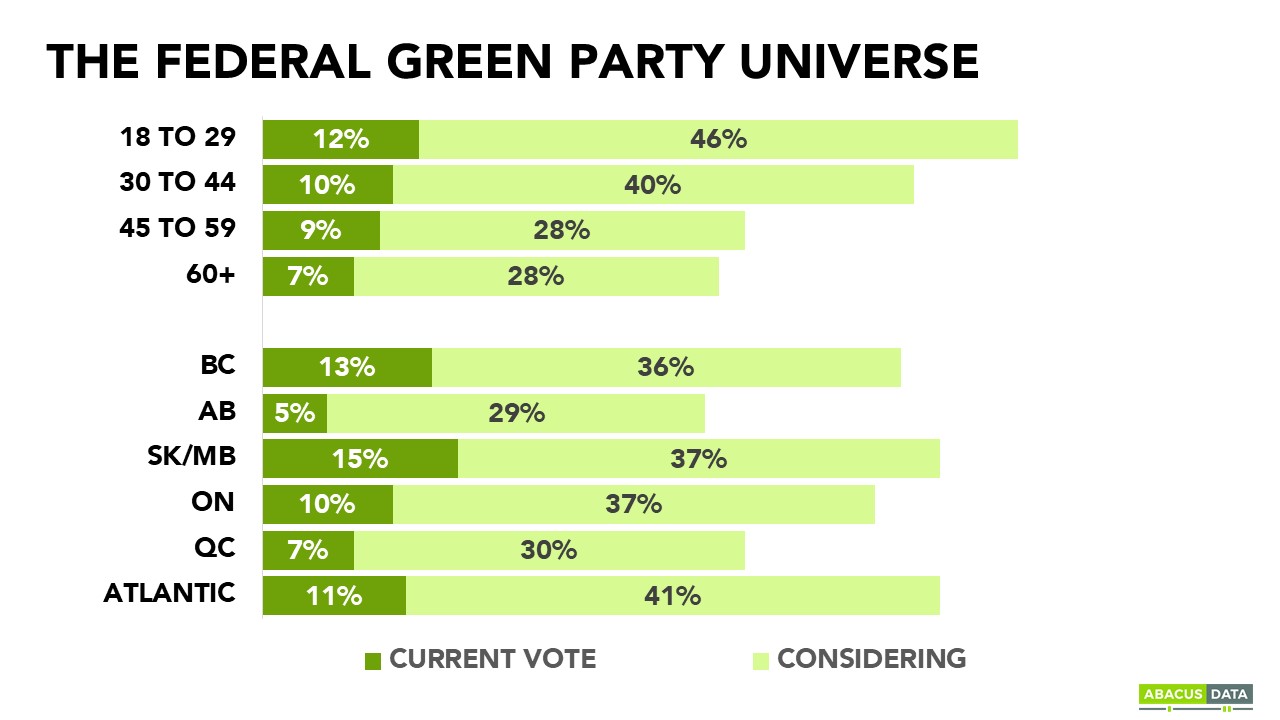
The 9% who say they would vote Green today is made up this way: ¾ voted Green in 2015, the rest comes mainly from those who voted Liberal or NDP in 2015 or who didn’t vote.

Those who say they would vote Green if an election were held today, estimate that there is a 72% chance that they will vote Green in October. Those considering Green but not decided say there is a 30% chance they will vote Green in October.
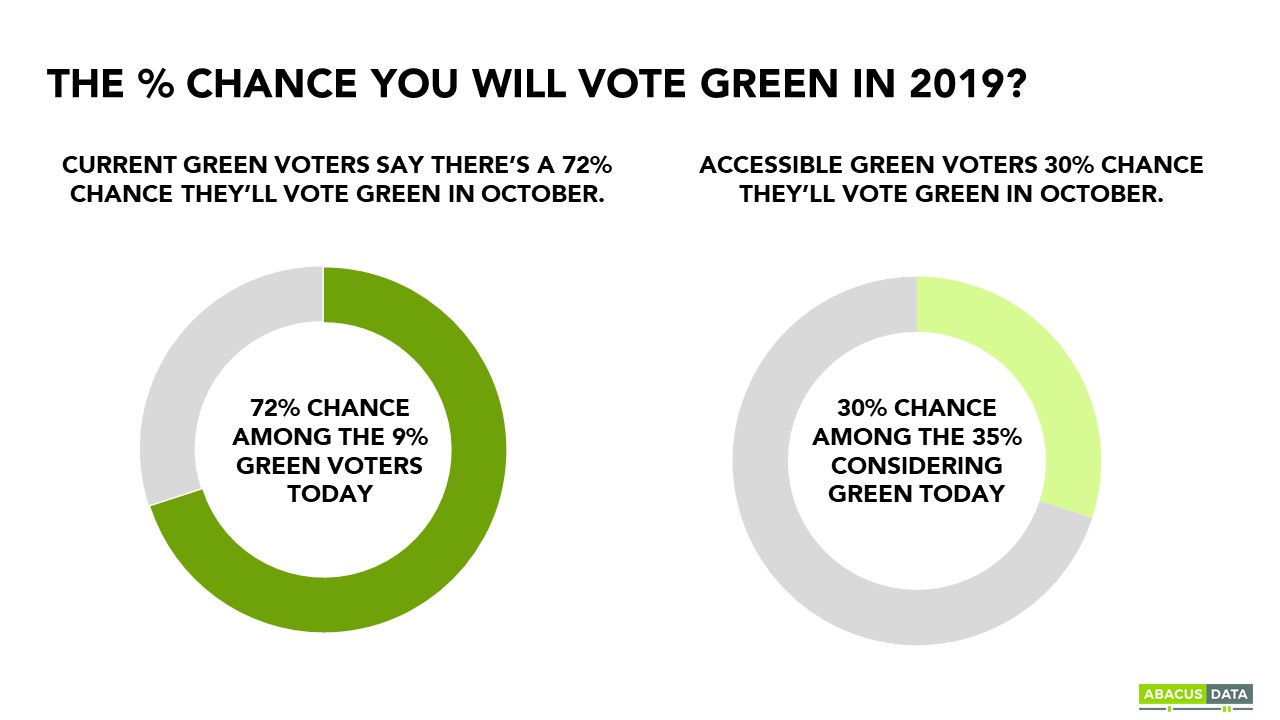
IF THEY LOOK AWAY FROM GREEN?
If we just focus on the accessible Green voter (the 35% who say they are considering the Green Party today but not ready to vote for them) 65% are also considering the NDP, 58% are considering the Liberals, 44% the Conservatives, 33% the BQ, and 33% the People’s Party. Asked who they are most likely to vote for, the Liberals would win 34%, the NDP 27% and the Conservatives 24%.


In an effort to explore the potential for a two-party race at the national level to turn into a question of strategic voting, we asked current and accessible Green Party voters whether they would be more likely to vote Liberal or Conservative if they lived in a riding where those two parties were the only ones in contention to win. Among current Green voters, the Liberals would win 63% compared to 37% for the Conservatives. Among accessible Green voters, the Liberals would pick up 58% compared to 42% for the Conservatives.
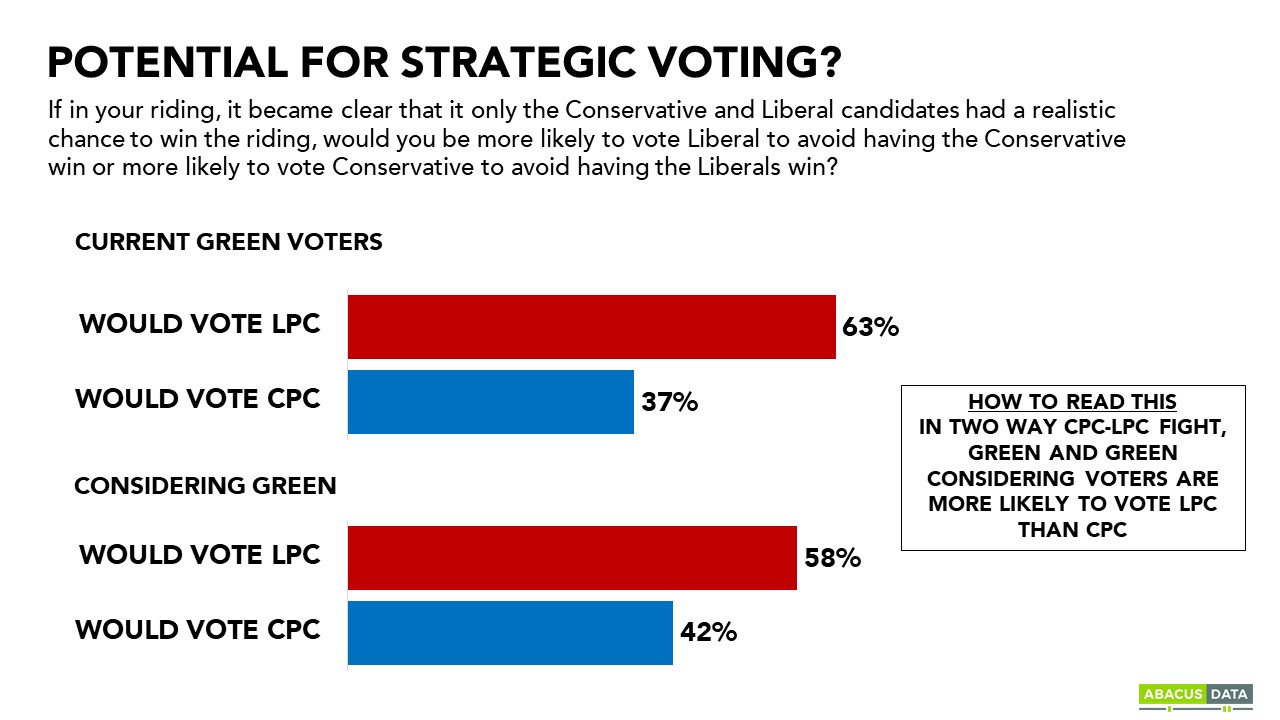
HOW THEY DO FEEL ABOUT THE LEADERS?
Current Green voters have a 79% positive view of Elizabeth May. They are 24% positive and 47% negative about Justin Trudeau. Their views of Andrew Scheer are 10% positive and 56% negative. Jagmeet Singh has a blend of 25% positive, 29% negative and 46% neutral.
Accessible Green voters are 57% positive towards Ms. May, which puts her ahead of the other leaders but by a smaller margin. 34% have a positive view of Mr. Trudeau, 30% are positive towards Mr. Singh and 22% have a positive view of Conservative leader Scheer.
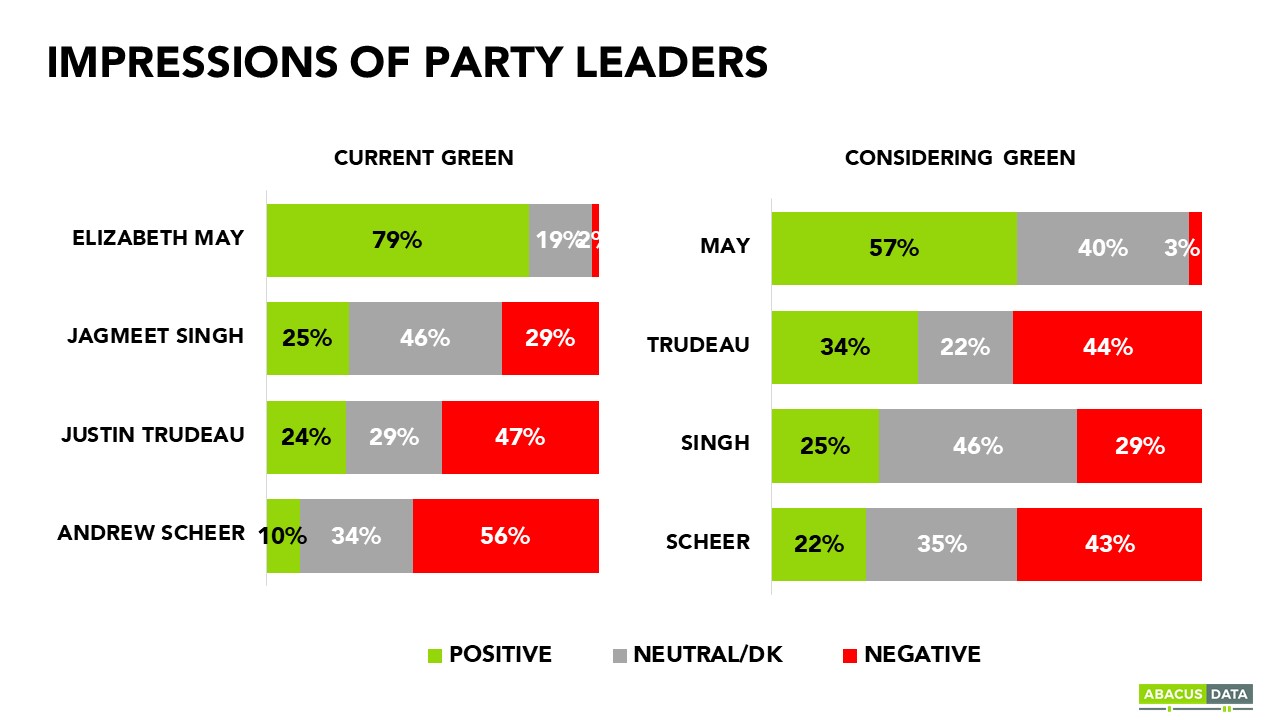
Asked which party leader they would prefer to see as PM after the next election, 81% of current Green voters say it is Elizabeth May, followed by 10% for Justin Trudeau, 4% Andrew Scheer, and 3% Maxime Bernier.
Among accessible Green voters 35% prefer to see Justin Trudeau as PM after the election, 26% Elizabeth May, 20% Andrew Scheer, 16% Jagmeet Singh and 3% Maxime Bernier.
Green voters and Green accessible voters have a negative view of Doug Ford and are three times more likely to have a negative view of Jason Kenney as to have a positive view of the Alberta Premier.
WHAT’S MOTIVATING GREEN VOTERS?
Among those who would vote Green today, 68% say they are motivated by positive feelings about the Greens, while a third say they are motivated by unhappiness with other parties. 20% say their motivation is more about Elizabeth May, 80% say it is about party values and policies.
50% say climate change is the driving issue for them, 50% say it is other environmental concerns.
Also noteworthy that one in three current supporters and one in three considering the Greens say their interest isn’t about the environment. It’s related to the party’s positions on other issues.
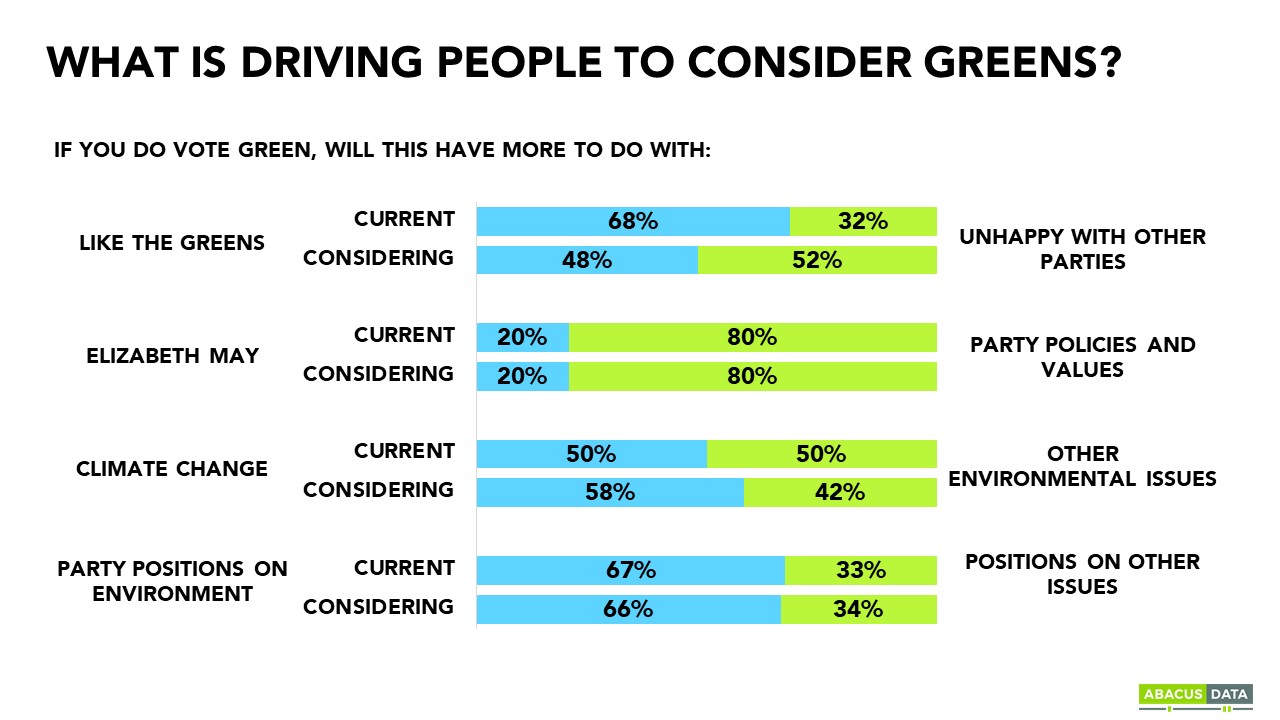
Some additional points worth noting:
Across Canada, 82% agree “climate change is a crisis and we need to take it more seriously”, including 46% who strongly agree. Among current Green voters, 65% strongly agree and a totally of 94% agree. Among Green accessible voters the numbers are very similar. Among Liberal and NDP voters the patterns are similar to those for the Green Party.
Interesting is the fact that 62% of current Conservative voters agree with this statement, and 85% of their accessible voters do as well. In Alberta, 68% agree “climate change is a crisis and we need to take it more seriously.”
Across Canada, 73% say they “want to see the Liberals adopt a stronger environmental agenda”, which includes 90% among current Liberal voters, 89% among current Green voters, 84% among Green accessible voters. Among accessible Liberal voters, 86% feel this way. Even 43% of current CPC voters share this view.
While most want a stronger environmental agenda, a very large majority (89%) say “environmental policies need to be pragmatic about the cost of living and the need for jobs.” This includes 87% in BC, 89% in Ontario, and 90% in Quebec. Among current Green voters, 80% agree, and among accessible Green voters, the number is 88%.
69% of those considering the Green Party say “the Conservatives would be the worst choice for the environment” as do 77% of current Green voters. Among those who aren’t currently considering the Green Party, 43% agree with this thought.
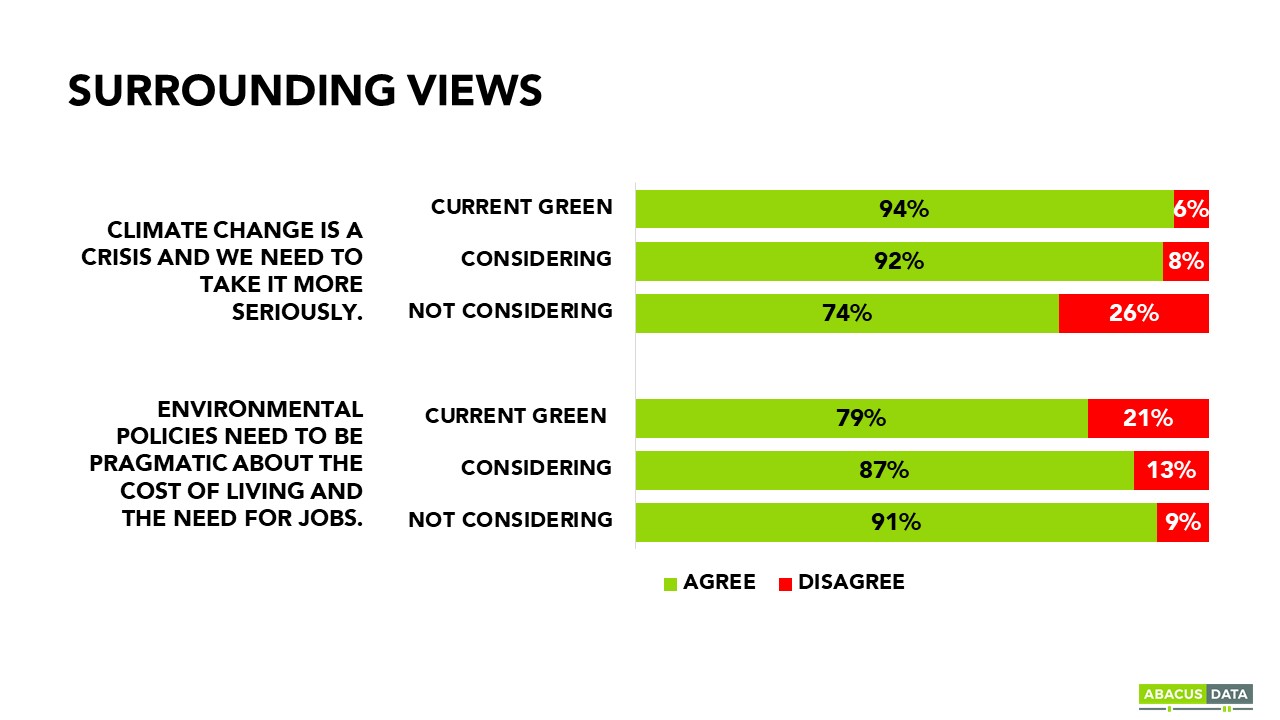

More than half of all those surveyed 61% say they are upset about the TransMountain pipeline. Among current Green voters, the number is 69%, among accessible Green voters, it is 66%. In BC, the number is 62%. Worth noting is that strong agreement with this statement is 22% nationally and is below 30% everywhere but Alberta, where 41% strongly agree that they are upset about the TMX pipeline. WHAT OUTCOME ARE GREEN VOTERS HOPING FOR?
Among those who would vote Green today, 35% would like to see a Green Party government, 43% say they are hoping for more Green MPs to influence the debate in Ottawa, 17% say they don’t really care if there are more Green MP’s as long as environmental issues are taken more seriously.
Among Green accessible voters, only 10% hope to see a Green Party government, 36% more Green MPs, while 41% don’t really care if there are more Green MP’s.

UPSHOT
According to Bruce Anderson: “Based on today’s snapshot, and how people who are thinking about voting Green describe the intensity of their intentions, the range of outcomes for the Green Party could be as low as 7% and as high as 17%. But of course, these ranges are tied to the current context – there will certainly be new variables introduced and fluctuations to come.
Based significantly on the focus of young people and the climate change issue, the Green Party is the fastest growing tent in Canadian politics. The Conservatives, while leading in the polls for most of this year find themselves relatively poorly positioned with these voters. The NDP seems to lack impact with these voters.
Voters thinking Green show some displeasure with the Liberals and an instinct to want them to go further, faster on environmental issues, but at the same time, there is a strong streak of pragmatism when it comes to economic and cost of living issues. If they feel the election will come down to a choice between Liberals and Conservatives, more Green votes will shift to the Liberal column than to the Conservatives. The TMX issue has caused some Liberal votes to shift towards the Green Party. However it’s worth wondering if the Conservatives push for a pro-pipeline agenda, will this risk driving Green voters towards the Liberal Party.”
According to David Coletto: “Over the past few months, we have seen a rapid increase in the number of Canadians looking at the Green Party as a viable option for their support. From 38% in December to 44% today. At the same time, the Green Party’s share of the vote has increased to 12% with support highest in BC, Saskatchewan and Manitoba, and Atlantic Canada. But there’s also been increases in Ontario and Quebec as well.
This broad-based supporter is driven primarily by support and interest among those under 44 but the party finds considerable interest from all age groups.
So far, interest in the Green Party seems to be a combination of concern about the environment and climate change and dissatisfaction with the other options on offer. Given that only 35% of Green voters would prefer to see a Green Party government elected in October is evidence of that. But there’s broad interest in seeing more Green MPs elected suggesting arguments focused on that could be helpful to the party in electing more MPs across the country.
With the by-election victory last month along with strong results in Atlantic Canada and BC, the Green Party has likely never been as well positioned as it is now to breakthrough. Elizabeth May is the only leader with higher positives than negatives and as many people would now consider voting Green as the NDP.
But with this growing interest also comes scrutiny and response from the other parties. Already the NDP has released an ambitious climate change plan and the Liberals will likely continue to make it central to their campaign this fall.
Given that almost half of Green supporters are open to voting Liberal or NDP and even more of its potential supporters are still open to those two parties means converting this latent support into actual votes remains the significant challenge for Ms. May and her party.
But as the 2011 federal election taught us, a wave can build quickly when the right conditions materialize. Many would have been hard-pressed to identify 10 ridings the NDP could have won in Quebec when that election started and the party ended up winning almost 60 seats.”
OTHER POLLS YOU MIGHT BE INTERESTED IN:
Will climate change be a ballot box issue in 2019
What policies do Canadians support to fight climate change?
METHODOLOGY
Our survey was conducted online with 1,500 Canadians aged 18 and over from May 27 to 30, 2019. A random sample of panelists was invited to complete the survey from a set of partner panels based on the Lucid exchange platform. These partners are double opt-in survey panels, blended to manage out potential skews in the data from a single source.
The margin of error for a comparable probability-based random sample of the same size is +/- 2.6%, 19 times out of 20. The data were weighted according to census data to ensure that the sample matched Canada’s population according to age, gender, educational attainment, and region. Totals may not add up to 100 due to rounding.
ABOUT ABACUS DATA
We are the only research and strategy firm that helps organizations respond to the disruptive risks and opportunities in a world where demographics and technology are changing more quickly than ever.
We are an innovative, fast-growing public opinion and marketing research consultancy. We use the latest technology, sound science, and deep experience to generate top-flight research-based advice to our clients. We offer global research capacity with a strong focus on customer service, attention to detail and exceptional value.
Contact us with any questions.
Find out more about how we can help your organization by downloading our corporate profile and service offering.
Don’t miss any of our releases and receive our weekly “Worth a Look” newsletter by signing up for our email list. We promise no more than 2 emails a week… unless there’s something really important we want to share.



